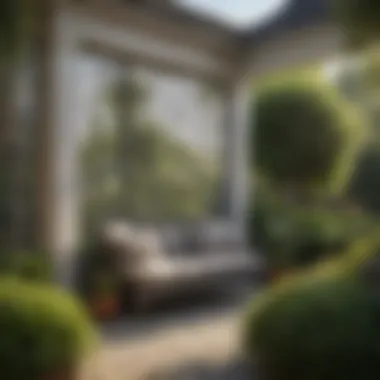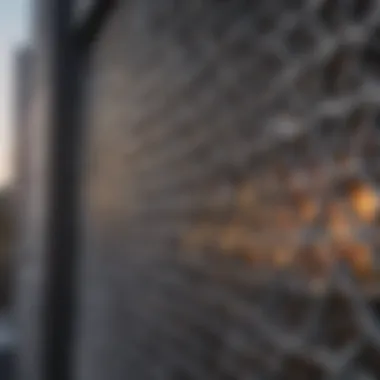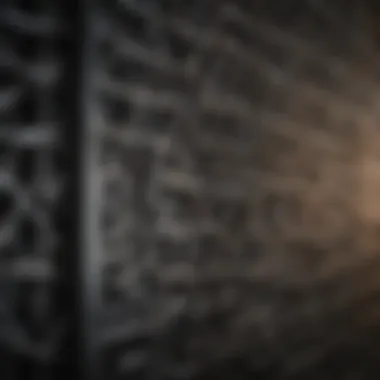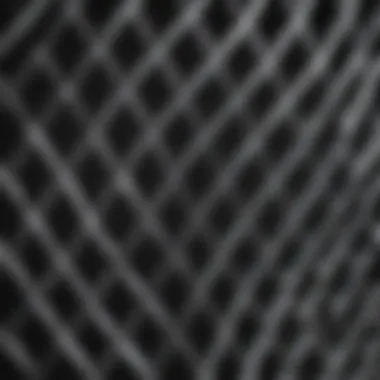Versatile Uses of Plastic Lattice Trim in Modern Design


Overview of Topic
Plastic lattice trim has become a notable player in the home improvement industry, serving a multitude of purposes that go beyond mere decoration. By definition, plastic lattice trim is a framework typically made from durable, weather-resistant plastic, designed to add structure and style to various outdoor and indoor spaces. It often features a crisscross pattern, which not only supports climbing plants but also enhances the aesthetic appeal of any landscape or building.
This material has gained traction for several reasons. Its lightweight nature makes it easy to handle and install, appealing to both seasoned DIY enthusiasts and those who may be tackling home improvement for the first time. Beyond its practicality, the versatility of plastic lattice trim allows it to be employed in diverse applications—from garden trellises to privacy screens, even as decorative panels.
Importance of the Topic
Understanding the significance of plastic lattice trim in the home improvement landscape is essential for homeowners looking to enhance their properties. This material embodies a growing trend toward more sustainable and efficient building practices. As sustainability becomes paramount, homeowners are increasingly turning to materials that not only meet their aesthetic needs but also their environmental concerns. With advances in manufacturing, plastic lattice trim offers a resilient choice that stands the test of time without the degradation seen in traditional wood options.
Plastic lattice trim serves as both a functional element and an artful addition, helping homeowners define their outdoor space creatively. Its adaptability allows it to blend seamlessly into various styles, from rustic to modern. Consequently, understanding this material's properties and applications allows homeowners to enhance their spaces intelligently, adding both character and functionality.
Common Challenges and Solutions
Despite its many advantages, homeowners often encounter issues when considering plastic lattice trim. These challenges can range from installation difficulties to aesthetic mismatches. Here are some common problems and solutions to keep in mind.
Common Issues Faced by Homeowners
- Limited knowledge on installation: Many homeowners are unsure how to properly install plastic lattice trim, leading to frustrating experiences.
- Compatibility with existing structures: Finding a trim design that complements existing architecture can be complex and daunting.
- Concern over durability: Given the myriad of products on the market, some may wonder if plastic lattice is indeed durable enough for long-term use.
Solutions and Tips to Overcome These Challenges
- Research Installation Techniques: Homeowners can find numerous tutorials and guides online that demonstrate the installation process clearly.
- Select a Design Style: Look for design inspirations in magazines or websites to identify a style that complements existing structures. Websites like Pinterest showcase various ideas.
- Choose Reputable Brands: Select well-known brands known for their durable plastic products. Reading reviews can offer helpful insights into the long-term performance of specific lattice trims.
"A well-informed homeowner is a successful one. Taking the time to learn about products before purchase yields better results in the long run."
Product Recommendations
When selecting plastic lattice trims, the choices can feel overwhelming due to the number and range of products available. It’s essential to focus on high-quality options that meet both aesthetic and practical needs. Here are several top products in the market:
- Seven Trust Composite Decking Lattice: Made from recycled materials, this lattice provides both durability and eco-friendliness. Its wood grain finish adds visual appeal, making it versatile for different uses.
- Veranda Plastic Lattice: Known for its wide range of colors and patterns, Veranda’s offering is highly regarded for aesthetic versatility. It’s UV resistant, ensuring vibrant colors that remain intact for years.
- DuraMax Vinyl Lattice: This brand’s lattice is recognized for its sturdiness and classic white look, perfect for fencing and decorative structures. Its maintenance-free characteristic appeals to many homeowners.
Benefits and Features
- Durability: These products are designed to withstand the elements without warping or splintering.
- Aesthetic Variety: Homeowners can select from various designs, colors, and styles, allowing for personalized touches in landscaping.
- Maintenance-Free: Most plastic lattice trims require little to no upkeep, saving time and effort for homeowners.
Step-by-Step Guides
Implementing improvements or solutions related to plastic lattice trim can be straightforward with a clear guide. Here’s a practical step-by-step approach to installing plastic lattice trim in your garden.
Practical Steps to Implement Improvements
- Gather Materials: You’ll need plastic lattice panels, wooden or plastic posts for support, fasteners like screws or brackets, and tools such as a saw, drill, and level.
- Measure & Mark: Determine where you wish to install the lattice. Measure the area accurately and mark where posts will go. Ensuring the area is level is crucial.
- Install Support Posts: Secure the supporting posts into the ground, ensuring they are firmly planted and upright.
- Cut the Lattice Panels: Based on your measurements, carefully cut the panels to fit your space.
- Attach Lattice to Posts: Use screws or brackets to attach the lattice to the posts, ensuring they’re secure and level.
- Finish the Edges: If necessary, use trim pieces to finish the edges for a polished look.
By following these steps, homeowners can create stunning lattice features that serve to enhance their landscapes effectively.
Prelims to Plastic Lattice Trim
Plastic lattice trim has become a go-to material in landscaping and construction, captivating homeowners and gardeners alike. It offers an attractive blend of functionality and style, making it an essential element in many design projects. This introductory section delves into the various dimensions of plastic lattice trim, from its characteristics to its numerous applications.
Definition and Overview
Plastic lattice trim can be defined as a lightweight, versatile decorative framework often used in outdoor spaces. Unlike traditional wood lattice, plastic versions are crafted from durable, weather-resistant materials, providing extended longevity whether it’s used for garden trellises or decorative fencing. Generally, this trim is characterized by crisscross patterns, which not only serve as a visual focal point but also promote vine growth and enhance privacy.
Some key features include:
- Variety of Colors: Most plastic lattice comes in a spectrum of hues, allowing for seamless integration into any aesthetic.
- Maintenance-Free Enjoyment: Homeowners appreciate that plastic lattice requires little upkeep unlike its wooden counterpart that demands regular painting or staining.
- Ease of Installation: Many products come ready to use, often requiring simple tools for setup, catering perfectly to those who prefer DIY projects.
In summary, plastic lattice trim brings a fresh take on outdoor design, marrying aesthetics with practicality.
Historical Context and Evolution


The timeline of plastic lattice trim tracks back to the evolving needs of homeowners seeking more durable and versatile options for their landscaping needs. Originally, lattice structures were mainly made from wood, establishing a rustic charm and functionality. Over time, as material technology advanced, the industry saw the introduction of synthetic materials that promised enhanced durability and versatility.
With the rapid development of plastic manufacturing in the late 20th century, designers began to adopt plastic lattice trim for various reasons:
- Weather Resistance: Traditional wood lattice often succumbed to rot, becoming less appealing and functional over time. Plastic, however, holds up against the elements, ensuring durability without the need for constant replacement.
- Cost-Effectiveness: As production techniques improved, plastic lattice became more affordable, opening doors for widespread use among homeowners who might have previously shied away due to budget constraints.
Its evolution from purely decorative to functional component marks a significant shift in landscaping trends. Today, users appreciate how plastic lattice trim enhances outdoor spaces while requiring minimal intervention, making it a favorable choice among modern house owners and gardeners alike.
Characteristics of Plastic Lattice Trim
Understanding the characteristics of plastic lattice trim is crucial for anyone considering its integration into their home or garden. These traits not only define its functionality but also determine its aesthetic appeal and long-term viability in various applications. Let’s explore the specific elements that make plastic lattice trim a preferred choice for many homeowners.
Material Composition and Properties
Plastic lattice trim is typically made from high-density polyethylene (HDPE) or polyvinyl chloride (PVC).
- Durability: These materials are known for their resistance to cracking and fading, making them suitable for outdoor use.
- Flexibility: The ability to bend without breaking allows for versatile designs that can easily adapt to various architectural styles.
- Cost-Effectiveness: Compared to wood or metal, plastic lattice trim offers a lower upfront cost while providing similar visual appeal.
This blend of strength and versatility ensures that plastic lattice trim can endure the test of time while maintaining its charm.
Durability and Weather Resistance
One of the standout attributes of plastic lattice trim is its exceptional durability and weather resistance. Unlike traditional wood or metal options that may warp, rust, or rot over time, plastic lattice trim performs remarkably well against the elements.
- Impervious to moisture: This prevents swelling or deterioration, crucial for regions with high humidity or rainfall.
- UV resistance: Many modern PVC products are treated to withstand the sun’s harsh rays, ensuring colors remain vibrant for years.
- Impact resistance: The material’s toughness helps it resist dents and scratches, making it ideal for high-traffic areas.
Homeowners can feel secure knowing that their investments are protected against the varying climates they might encounter.
Weight and Handling
When it comes to weight and handling, plastic lattice trim presents an advantage over heavier materials like wood or metal. The lightweight nature of plastic makes it easier to handle during installation.
- Ease of installation: A typical homeowner can manage the application without extensive help or special equipment.
- Transportability: Because plastic lattice trim is lighter, transporting it to your project site is less cumbersome, leading to lower overall labor costs.
- Flexibility in design: Lighter materials often allow for a variety of configurations, which enables creativity in landscaping and architecture.
In summary, the characteristics of plastic lattice trim—including its material properties, durability against weather conditions, and ease of handling—make it a compelling choice for renovations and new projects alike.
Applications of Plastic Lattice Trim
Plastic lattice trim is a versatile and functional material that shines in various applications across landscaping and architecture. This section will delve into its many uses, highlighting how it can enhance both aesthetics and functionality in outdoor spaces. The broad range of applications underscores its significance—whether for creating boundaries, supporting plant growth, or adding decorative touches. Not only does plastic lattice trim adapt to different styles and preferences, it also offers practical solutions that cater to modern needs.
Landscaping Uses
Landscaping often requires elements that not only look good but also serve practical purposes. Plastic lattice trim fits this bill perfectly, providing visual appeal while supporting architectural and botanical design.
The lattice can be strategically placed to define garden boundaries, support climbing plants, or create privacy without completely blocking views. Not to mention, its lightweight nature makes it easy to install in various layouts.
- Garden Support: Using lattice to support climbing plants like vines or certain vegetables can enhance growth by allowing for better air circulation and sunlight exposure.
- Boundary Marking: Instead of relying solely on solid fences, plastic lattice trim can delineate property lines in a subtle yet effective way, offering a more open feel to your yard.
- Decorative Panels: Lattice can be incorporated as decorative features in garden beds, such as backdrops for flower beds, thus adding depth and texture to the landscape.
Architectural Features
Plastic lattice trim is more than just a supporting feature in landscaping; it contributes to architectural designs as well. From providing security to enhancing the overall look of the structure, it serves various functions.
Fencing Solutions
When it comes to fencing, plastic lattice trim offers a popular alternative to traditional wooden or metal fences. The lightweight material allows for easy installation and flexible designs. One of its key characteristics lies in the combination of visibility and privacy it provides.
This means you can keep eyes out while still letting light filter through. It's particularly beneficial for gardeners wishing to maintain visibility while creating enclosed areas for plants.
- Unique Feature: Its ability to be colored or painted makes it adaptable to any home’s exterior. A carefully chosen color can match or contrast beautifully with the existing structure, seamlessly blending into the environment.
- Advantages: Unlike wood fences, which may warp or rot over time, plastic lattice trim is durable and less susceptible to harsh weather conditions—a big plus for homeowners seeking longevity without the hassle of frequent repairs.
Decking Enhancements
Incorporating plastic lattice trim into decking projects can add an element of sophistication. It provides a clean finish while keeping clutter hidden away under the deck. This arrangement not only aids in maintaining a tidy appearance but also protects storage space from the elements.
- Key Characteristic: The easy installation process allows homeowners to customize the look of their deck considerably. It can even harmonize with other materials like wood or stone for a more unified appearance.
- Disadvantages: While it’s a low-maintenance option, particular colors may fade over time if exposed to extensive sunlight, which might require periodic touch-ups.
Lattice Screens


Lattice screens function as functional barriers while also adding an artistic touch to spaces. The careful placement of these elements can define areas, creating enclaves for relaxation or gardening.
- Key Characteristic: The transparency of the lattice allows for light and airflow, helping maintain a breathable environment, important for plant growth and comfort in patio spaces.
- Benefits: Additionally, planting flowering vines or climbing plants in front of these screens can create stunning living walls, enriching the aesthetics of outdoor living areas.
Outdoor Structures
Plastic lattice trim holds significant potential in constructing outdoor features that meld form with function. It is an excellent choice for many functional structures such as pergolas, arbors, and trellises. These structures enhance the usability of garden space while also showcasing creativity.
Pergolas
Pergolas built with plastic lattice trim provide shade and ambiance to outdoor areas. The decisive detail here is that they create a defined outdoor space without entirely closing it off from nature.
- Benefits: Homeowners can train climbing plants to grow along the structure, resulting in a delightful shaded area ideal for relaxation. This function allows for outdoor enjoyment even in warm weather.
- Unique Feature: It’s the fusion of support and design that carries through in a pergola constructed with lattice, showcasing open air while offering shelter.
Arbors
Arbors intensified by plastic lattice trim can serve as stunning entry points to gardens or pathways. They guide visitors and make outdoor areas feel cohesive and intentional. The distinct features of arbors create inviting transitions into various garden sections or living spaces.
- Key Characteristic: A well-placed arbor can become a centerpiece, especially when decorated with climbing plants and seasonal flowers that frame the lattice.
- Drawbacks: It is worth noting that if not anchored properly, lighter materials may be susceptible to wind damage, which requires thoughtful planning during installation.
Trellises
Trellises made from this trim type are indispensable for those passionate about gardening. Their utility extends beyond mere decoration; they create vertical growing spaces that maximize small areas, letting plants thrive.
- Key Characteristic: Their design facilitates easy plant training, as gardeners can guide vines and other climbing plants to grow along the trellis when they begin to reach out.
- Advantages: In addition, their lightweight nature makes repositioning or adjustments easy, allowing for regular reorganization based on plant health and growth patterns.
Plastic lattice trim truly showcases flexibility and adaptability, making it a vital component in various outdoor applications. The inherent advantages it carries ensure that it fits seamlessly into diverse projects, whether enhancing landscape designs or serving structural functions.
Advantages over Traditional Materials
In thinking about building materials today, comparing plastic lattice trim to traditional options like wood or metal is a no-brainer. This segment digs into why plastic lattice trim is becoming a favorite among homeowners and builders alike. With budget snugging benefits, straightforward installations, and minimal upkeep, it’s clear why more people are leaning towards this innovative solution.
Cost-Effectiveness
When it comes to budgeting for home projects, plastic lattice trim shines bright. Traditional materials like wood can burn a hole in your pocket, particularly when you factor in the costs of maintenance and regular treatment needed to keep them looking spiffy. In contrast, plastic lattice trim provides similar aesthetic benefits without needing frequent touch-ups. While the initial price can be higher than cheap wood alternatives, the long-term savings make plastic a smart choice; you won't be splurging for things like paint, stains, or weatherproofing. Plus, with a wide array of styles available, there’s something that fits every pocketbook and taste.
Ease of Installation
One of the great joys of using plastic lattice trim is how simple it is to work with. Unlike traditional materials that can be pretty cumbersome, plastic is lightweight. This means less back-breaking labor! Most house owners can easily manage installations with mere hand tools. You won’t need a squad of construction pros to tackle a project. All of this translates to a quicker turnaround time from concept to completion. Additionally, many plastic lattice products come with pre-drilled holes, guiding you along your way like a good GPS in uncharted territory.
Low Maintenance Requirements
After the project is done, the last thing you want to do is keep hammering away at it to maintain its looks. Here is where plastic lattice trim truly stands out—its maintenance is about as low as it gets. Traditional wood requires regular sealing, staining, or painting to fend off rot or cracking. Plastic lattice trim, however, is highly resistant to the elements—rain, snow, and harsh sun are mere hiccups for this tough material. A quick rinse with the hose now and then is generally all that’s needed to keep it looking fresh and tidy. This not only saves time but lets you enjoy your outdoor areas without stress.
"Choosing plastic lattice trim often results in both financial savings and hassle-free ownership, making it a wise choice in today’s climate-conscious world."
The advantages of plastic lattice trim over traditional materials are clear. It delivers cost savings, simplifies installations, and minimizes ongoing care, making it ideal for any homeowner looking to enhance their property with ease and style. Whether for aesthetics or practicality, embracing this material can lead to smart decisions that stand the test of time.
Design Possibilities with Plastic Lattice Trim
Designing with plastic lattice trim opens up a world of possibilities for homeowners seeking to enhance their spaces. This versatile material not only serves a practical purpose but also brings aesthetic richness to landscapes and architecture. By understanding the various design elements, benefits, and considerations, one can truly leverage plastic lattice trim to its fullest potential.
Color and Finish Options
When it comes to color and finish, plastic lattice trim offers a vibrant palette that can cater to any taste. Whether you prefer the classic white, which complements almost any setting, or more daring hues like mild greens or deep browns, the choices are plentiful.
"Picking a color can be like picking paint for your walls – it can either blend or pop!"
Moreover, the finish can vary from matte to glossy, allowing homeowners to coordinate with existing elements in their outdoor or indoor spaces. Considerations such as fading resistance and weatherproofing also come into play, ensuring that the chosen color maintains its vibrancy over time. In combination with other landscaping features, these options enable a seamless visual experience.
Integration with Other Materials


The adaptable nature of plastic lattice trim means it can be easily integrated with other materials for an eclectic look. Whether combined with wooden posts for a rustic fence, or paired with stone elements to create a robust feature, plastic lattice can provide contrast and depth. Notably, when using lattice trim alongside metal fixtures, one can achieve a striking contemporary style.
Think about how lattice can enhance a wooden pergola or how it can be used to create a standalone privacy screen against a brick wall. This integration not only maximizes visual appeal but also enhances functionality, making spaces feel more connected and designed. Here are some common combinations:
- Wood: Add warmth and texture to your designs.
- Metal: Introduce modern accents.
- Brick or Stone: Ground your designs in nature.
Customizing Shapes and Patterns
The customization of shapes and patterns using plastic lattice trim is where creativity can truly shine. The material can be cut and shaped in numerous ways, allowing homeowners to create unique profiles and designs tailored to their individual tastes. You might craft a diamond pattern for a classic look or opt for more flowing circular designs to soften hard landscaping edges.
Not only can one select standard sizes, but they can also request custom dimensions that fit specific areas or requirements. Think of using lattice not just as a flat screen, but as an artistic element; for instance, a curved arch of lattice over an entrance can evoke a garden-like feel. Here's how to consider customizing:
- Shapes: Rectangles, circles, or intricate geometrical designs can create focal points.
- Patterns: Combining different patterns can lead to striking visuals.
By harnessing these design possibilities, homeowners can transform their spaces using plastic lattice trim in innovative and stylish ways.
Environmental Considerations
In recent years, the conversation surrounding building materials has taken a noticeable shift towards sustainability. Plastic lattice trim, while being a versatile and adaptable material, also raises questions and considerations about its environmental impact. Understanding these implications is essential for homeowners and landscapers alike, as they strive to create spaces that are not only aesthetically pleasing but also environmentally responsible. This section highlights the crucial elements of recyclability, sustainable manufacturing practices, and the effects on wildlife and ecosystems.
Recyclability of Plastic Lattice Trim
Recyclability refers to the ability of a material to be processed and reused for different purposes after its initial use. Plastic lattice trim typically falls into the category of materials that can be recycled, helping to minimize waste and reduce the demand for virgin materials.
Key points about recyclability include:
- Many local recycling programs accept certain types of plastic trim, making it accessible for conscientious homeowners.
- It is important to check with local recycling centers to confirm acceptance and guidelines, as they can vary widely.
- Engaging in proper recycling practices not only contributes to waste reduction but also conserves resources that could go into producing new materials.
"Choosing recyclable materials, like certain types of plastic lattice trim, allows projects to align with eco-friendly goals."
Sustainable Manufacturing Practices
The sustainability of plastic lattice trim goes beyond its recyclability; it also encompasses the practices involved in its production. Manufacturers are increasingly aware of the environmental implications of their processes, leading to innovations in sustainable production methods.
Considerations in sustainable manufacturing include:
- Use of recycled content: Many producers are incorporating recycled plastics into their lattice products, thus closing the loop and reducing the demands on natural resources.
- Energy-efficient processes: Modern manufacturing often employs energy-saving technologies and renewable energy sources to minimize the carbon footprint of production.
- Water conservation efforts: Many facilities strive to reduce water usage, ensuring that the manufacturing process is as environmentally friendly as possible.
Impact on Wildlife and Ecosystems
When evaluating environmental considerations, it is essential to consider how materials impact local wildlife and ecosystems. While plastic lattice trim offers various benefits, we must also understand its implications for the environment.
Some potential impacts include:
- Habitat disruption: If improperly disposed of, plastic waste can journey into natural habitats, posing dangers to wildlife. Educating consumers on proper disposal and recycling options can mitigate this risk.
- Degradation in ecosystems: Non-biodegradable plastics can potentially harm the ecosystem if they accumulate in certain areas. This emphasizes the need for careful planning regarding the material's life cycle and post-use management.
- Introducing new materials: Innovative uses of plastic lattice trim in landscaping can help create habitats or refuge areas for small wildlife if designed thoughtfully.
In summary, the environmental aspects of plastic lattice trim weave a narrative about responsibility and mindful consumption. With insights into its recyclability, sustainable production practices, and awareness of ecological impacts, homeowners can make choices that benefit not only their surroundings but also the wider environment.
Final Thoughts on Plastic Lattice Trim
As we wrap up our exploration of plastic lattice trim, it's crucial to emphasize how this versatile material stands to redefine landscaping and architectural elements. From its burgeoning popularity to its compelling mix of functionality and aesthetic appeal, plastic lattice trim serves as a bridge between form and function, making it a top choice for homeowners and designers alike.
Future Trends in Materials
Looking ahead, the materials used in plastic lattice trim are on the verge of significant transformation. With ongoing innovations, we might expect to see enhancements in durability and design flexibility. Eco-friendly alternatives are surfacing, pledging not only structural integrity but also sustainable practices, aligning with the growing awareness regarding environmental consciousness among consumers. Composite plastic blends that utilize recycled materials are likely to become more prevalent, as they not only lessen the material’s carbon footprint but also retain that desirable aesthetic quality.
- Integration with Smart Technology: Future developments might even incorporate technology, allowing lattice structures to interact with sensors or smart irrigation systems, optimizing landscaping upkeep further.
- Customization and Personalization: Advances in manufacturing could lead to more customizable options, allowing homeowners to select specific patterns, sizes, and colors that resonate with their personal taste and home style.
Culmination
In summary, the discussion surrounding plastic lattice trim showcases its multifaceted applications in contemporary architecture and garden design. Its strengths—such as low maintenance, resistance to weather elements, and ease of installation—make it a standout option when considering societal and environmental factors. More than just a decorative element, plastic lattice trim embodies practicality with style, positioning it as a formidable rival to traditional materials.
Through effective use, it meets the needs of both design aesthetics and functional requirements. The insights provided in this article aim to equip housewives and homeowners with the knowledge to effectively implement this material in their own spaces.
Relationships between viewer expectations and material performance will continue to evolve, reinforcing the notion that plastic lattice trim is not just a passing trend, but rather a enduring fixture in the realm of home improvement and architectural solutions.
"Lattice trim is where creativity meets practicality, offering both beauty and utility in one modest package."
As we forge ahead, let’s continue to embrace the innovative spirit behind these materials, enriching our living spaces while remaining mindful of our environmental responsibilities.







